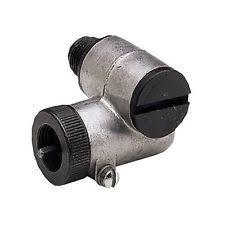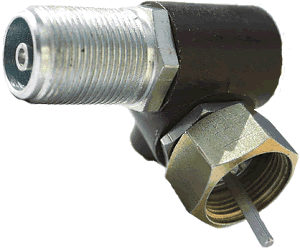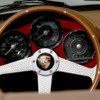
 Has anyone tried one of these right angle adapters for the speedometer? I’m wondering if it would make the speedometer needle more stable and allow us to move the speedometer to the proper location.
Has anyone tried one of these right angle adapters for the speedometer? I’m wondering if it would make the speedometer needle more stable and allow us to move the speedometer to the proper location.
Replies sorted oldest to newest
A longer speedo cable would be easier and cheaper.
For my installation, the length of the cable is not the problem. It’s the angle that is the speedometer.
A longer cable will give more graceful curves to the drive cable. It's the sharp bends in the cable and perhaps old grease (or lack of) that contribute to inner cable binding and spurting on release. Of course ultimate (Madness) is a new GPS controlled speedo from SE/Beck.
Is that one for a VW Jetta?
I see quite a few of these right angle adaptors and since I'm not sure of our cable's specs, I don't know if they will fit.
I've seen several that are 5/8-18 with a .104 square drive pin.
Does the GPS speedo work as long as their is a clear sky?
Do you know if it fits the Vintage Speedster speedo cutout, or is it the original size?
I’ve had the GPS speedo for most of one season now. Zero issues with connectivity even on the cloudiest days.
You might be able to use the speedo cable from a Super Beetle.
A GPS signal being received isn't really affected by clouds. You are getting GPS signals from 5-8 satellites. Bad weather can affect the accuracy of the signal received but you're driving a car on the road and not launching a Tomahawk missile. (Military GPS are much more accurate than those sold for civilian use where 30' doesn't make a difference) Heavy rain, snow and ice will create inaccuracies.
Cole Thompson- posted:I see quite a few of these right angle adaptors and since I'm not sure of our cable's specs, I don't know if they will fit.
I've seen several that are 5/8-18 with a .104 square drive pin.
Does the GPS speedo work as long as their is a clear sky?
Do you know if it fits the Vintage Speedster speedo cutout, or is it the original size?
The GPS Speedo, fuel, and tachometer that Carey sells are SLIGHTLY smaller, 100mm vs 105/110mm??, but he includes a trim ring that fills up the gap.
WOLFGANG posted:A GPS signal being received isn't really affected by clouds. You are getting GPS signals from 5-8 satellites. Bad weather can affect the accuracy of the signal received but you're driving a car on the road and not launching a Tomahawk missile. (Military GPS are much more accurate than those sold for civilian use where 30' doesn't make a difference) Heavy rain, snow and ice will create inaccuracies.
I don't know. Some of you guys running the bigger engines might give that missile a run. ![]()
Cole Thompson- posted:
When moving my refurbished VDO gauges to their proper spots, with the speedometer on the right, I looked into right angle drives.
There were two sources:
Texasindustrialelectric.com, would make up a custom unit for around $250
North Hollywood Speedometer thought that it might be getting some in for about $130
The only problem with the drive is that, at least in my car, there is a metal bar behind the dash that gets in the way as well as a mess of wiring. So I tried a number of stock VW cables, the closest being one for right-hand drive. But that was a bit too long. So I had a custom 1650 mm long cable made by Palo Alto Speedometers.
This works out well, but the needle bounces around when I hit a bump. On smooth roads, no problem. Hit a bump and it’s all over the place. I’m pretty sure this has nothing to do with the cable. But who knows?
According to Speedhut who made my gauges, the GPS speedo works everywhere except parking garages. I have found this to be true in practice as well. Even heavy tree-canopied roads don't seem to affect it.
The GPS Satellite radios are working way up there at something like 1200 and 1500 Megahertz (MHZ).
The lower you go in frequency, the more the signal is affected by atmospheric issues like weather, changes in the ionospheric altitude between night and day, a whole bunch of stuff. When you surf the AM band at night and the "skip" is in, that means that the ionosphere (a bubble of ionized particles above the earth) has positioned itself such that electro-magnetic radio waves bounce between the earth and the bottom of the ionosphere, sometimes several times or more, to allow communication between distant places. Ham operators use this all the time, and its' effectiveness varies by frequency used, time of day and compass direction. That's how you can hear distant AM stations, but only at night when the ionosphere changes and charges differently.
You only very rarely see "skip" on TV or FM channels, because of the higher frequencies used. If you go high enough in frequency, the "skip" possibility disappears and everything is "line-of-sight" communications, only, although some Ham operators do "Moon Bounce" where they bounce 145 MHZ or 220 MHZ signals off the moon as an ionosphere replacement (think big, honkin' reflector). The signal coming back is pretty weak, so you need low-noise conditions and a Super-Sniffolator 5000 receiver to hear them, but they're doing it every day/night.
The GPS signal is (a.) line-of-sight (the satellite must be within your field of vision, and typically, 5 - 8 of them is best) and (b.) working at a frequency that "sees through" environmental issues. Most of the time, enough of the signal can get through tree canopies to be useful and there is a lot of buffering (storing and error-checking of the signal) going on inside of your GPS unit. That's why it takes a few seconds for the GPS to wake up when you first start it - it has to acquire all of the Sats in view, then error correct and buffer and THEN it's ready to use. However, the GPS signal can't go through thicker walls like enclosed parking garages, so some places, like garages and tunnels, have GPS transponders inside so your gizmo keeps working. I think the tunnel under Boston and Baltimore harbor is like that.
Anyway, an explanation with too many words, but I hope you found it interesting.
Gordon, I started falling asleep at about: The GPS radios are working way up there...
Just kidding! It was informative and good to know!
HOW they work is pretty cool, too, based on time differentials over distance between synchronized, moving, atomic clocks.
I'll let @El Frazoo explain THAT one!
Totally different than how cell phones work, by changing frequencies between your smaht phone and different cell phone towers on the fly. Heddy Lamar (yes, the actress) holds the patent for how that's done, intended to prevent jamming of torpedoes and first used in the 1960's. Same technology is used in WiFi and Bluetooth. Pretty cool lady.
A very cool feature of GPS speedo: It works in reverse, or whatever direction you happen to be traveling! Don't try this at home, folks!
That's good to know, the next time I'm sliding sideways at 40mph....
Cole Thompson- posted:Gordon, I started falling asleep at about: The GPS radios are working way up there...
Just kidding! It was informative and good to know!
Baaaaa... good one... that made me chuckle. ![]()
I have to make a minor correction to Gordon's post. Some atmospheric phenomena affect the lower frequencies while other have more affect on the higher ones. In a past life I was a software developer for a Ku-band (11-13GHz) satellite business network. One of the first things we learned was how much rain affected the higher frequencies and it worsened as they went up. Ka-band (15-17GHZ I believe) was far worse. That's why those with satellite TV (Dish and Direct TV) have rain-related dropouts. I wish I could remember the physics of it, but it had something to do with the shape of the falling rain drops (oblate spheroids), and that's all I remember.
I hate those friggin oblate spheroids! I had some for about a month and finally had them removed.
And I’ve never seen a Ku or Ka Band, do they sound similar to ska?
Oblate Spheroid, I loved his work in the first James Bond film.
>
>
Science, shmience.
Must be a lot of Protestants on here! Any Catholic (even an ex like me) could tell you that an oblate spheroid is the Frisbee that young seminarians throw when they're goofing around on campus.
Cole wrote: "And I’ve never seen a Ku or Ka Band, do they sound similar to ska?"
I dunno - the older Ska sounds of the 60's before Reggae or after Punk discovered it and made it into Heavy Metal? Jimmy cliff or Simply Stoopids?
Either way, if you ran Kμ or Ka signals through an FSK converter (a little old school, there) to audio output it would probably sound more like the Dischord Crew
You lost me at ionospheric altitude (way over my head)
Yeah Bill, we used to skip right over your head when running military phone patches for servicemen and women in SEA in the 60's and 70's. All kinds of places from ships to Cam Rahn Bay to landing zones - wherever they had a ham op, a transceiver and antenna.
Skip started coming in from SEA for New England around 9-10PM EST and stayed with us til 3-5AM. You guys in Hawaii were 7pm - 1AM, but there was a lot of noise from the West Coasters. 14.305 MHZ Ham band and just under 14.000 for Navy MARS and sometimes on 21.305 MHZ (15 meters) if CX favored that route. On frequency every night after my homework for 8 years (all through college), running 10-20 patches each night, CX permitting. Rig was the Hallicrafter twins - HT-44 and SX-117 and the power amp was a kilowatt surplus ship-board transmitter, re-purposed. Countless phone patches run over 8 years. Skip CX are pretty cool.
The $#!+ you remember from 50 years ago.
And what was this thread really about?
Sorry for the memory ramble, folks. My wife says I'm just being a smaht a$$...
Did we ever answer Cole's query about right angle speedo cable adapters?
I solved my problem another way: I purchased one of Carey’s VDO gauge sets with the GPS speedometer.
Now my gauges will be in the correct position and the speedometer will be steady.
Bravo, Cole!
Changing subject ( I know that’s never been done here before and is SEVERELY frowned upon): what is the correct position for the three gauges?
I assume it is speedometer on the right, tachometer in the center and the cluster gauge on the left?
My speedo has been on the left and is partially obscured by the steering wheel.
What has anyone done to address this?
I can’t adjust my steering wheel, or my seat height...so what’s left, steering wheel diameter?
420mm wheel size ![]()
Attachments
>
>
IaM-Ray posted:420mm wheel size

yeah, but you better have short legs!
Tom Blankinship posted:Having the speedo on the right makes it much easier to see.
>
>
If your right handed ![]() . What if your left handed ?
. What if your left handed ?
I’ve had bith and I am not sure it makes a difference.... just saying
I only look at my tach when not using my ears...
I would love a steering wheel like that!





